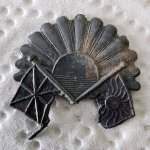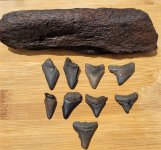1869er
Full Member
- Jan 5, 2009
- 142
- 29
- Detector(s) used
- White's MXT, Garrett Freedom 2 C.C., 1st detector was a 1970's Compass, Finished a MD Surf PI from a kit - my most recent MD.
- Primary Interest:
- All Treasure Hunting
I do a fair amount of beach hunting in Florida, not sure if this is the same on all beaches. However I have a question to see what others think.
As the tide receeds, and in my own hunting methods, I find there are long stretches of shell laden lines running up and down the beach areas parallel to the water line. I usually follow these shelly lines because I assume the shells are heavier, and I assume and have a hunch that heavier items like gold, and coins, and other metallic items also settle in these spots too. Do you also search your beaches this way? Or do you follow along bare sandy areas instead? I find more shells in troughs as well, and again I assume heavier stuff settles in these troughs. I think the shells group in peak tidal spots, low and high tides.
Anyway, just wondering what others think about this search technique? Is my logic sound? Or unrealistic search techniques?
As the tide receeds, and in my own hunting methods, I find there are long stretches of shell laden lines running up and down the beach areas parallel to the water line. I usually follow these shelly lines because I assume the shells are heavier, and I assume and have a hunch that heavier items like gold, and coins, and other metallic items also settle in these spots too. Do you also search your beaches this way? Or do you follow along bare sandy areas instead? I find more shells in troughs as well, and again I assume heavier stuff settles in these troughs. I think the shells group in peak tidal spots, low and high tides.
Anyway, just wondering what others think about this search technique? Is my logic sound? Or unrealistic search techniques?
Last edited:
Upvote
0




